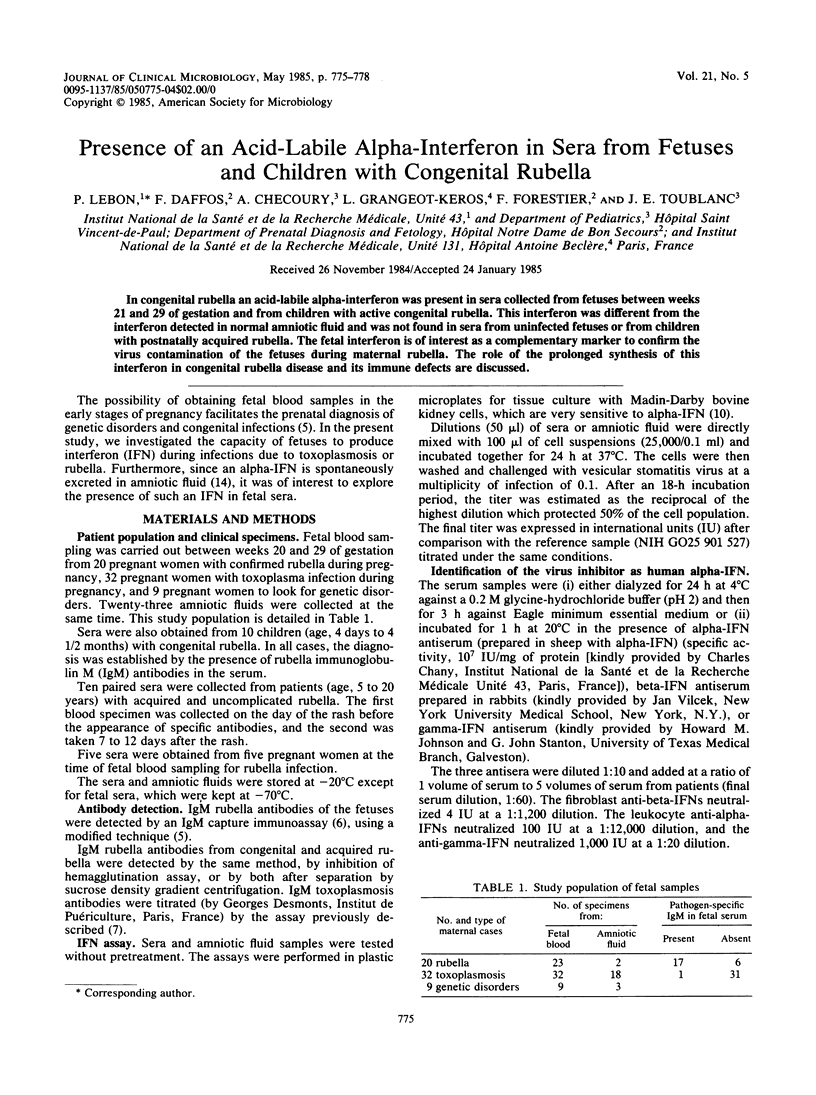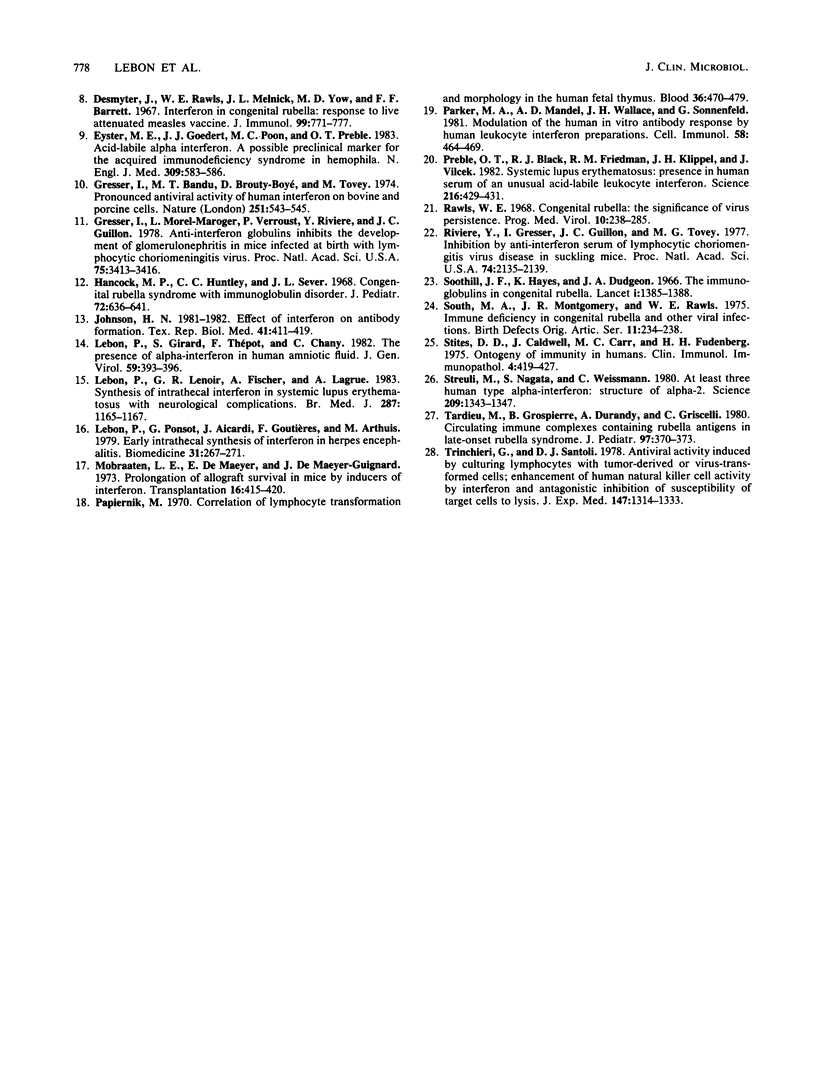Abstract
In congenital rubella an acid-labile alpha-interferon was present in sera collected from fetuses between weeks 21 and 29 of gestation and from children with active congenital rubella. This interferon was different from the interferon detected in normal amniotic fluid and was not found in sera from uninfected fetuses or from children with postnatally acquired rubella. The fetal interferon is of interest as a complementary marker to confirm the virus contamination of the fetuses during maternal rubella. The role of the prolonged synthesis of this interferon in congenital rubella disease and its immune defects are discussed.
Full text
PDF



Selected References
These references are in PubMed. This may not be the complete list of references from this article.
- ALFORD C. A., Jr, NEVA F. A., WELLER T. H. VIROLOGIC AND SEROLOGIC STUDIES ON HUMAN PRODUCTS OF CONCEPTION AFTER MATERNAL RUBELLA. N Engl J Med. 1964 Dec 17;271:1275–1281. doi: 10.1056/NEJM196412172712501. [DOI] [PubMed] [Google Scholar]
- Bergeret M., Grégoire A., Chany C. Protective effect of interferon on target cells exposed to cellular cytotoxicity. Immunology. 1980 Aug;40(4):637–643. [PMC free article] [PubMed] [Google Scholar]
- Buimovici-Klein E., Lang P. B., Ziring P. R., Cooper L. Z. Impaired cell-mediated immune response in patients with congenital rubella: correlation with gestational age at time of infection. Pediatrics. 1979 Nov;64(5):620–626. [PubMed] [Google Scholar]
- Buimovici-Klein E., Weiss K. E., Cooper L. Z. Interferon production in lymphocyte cultures after rubella infection in humans. J Infect Dis. 1977 Mar;135(3):380–385. doi: 10.1093/infdis/135.3.380. [DOI] [PubMed] [Google Scholar]
- Denoyel G. A., Gaspar A., Peyramond D. Diagnosis of recent rubella virus infection by demonstration of specific immunoglobulin M antibodies: comparison of solid-phase reverse immunosorbent test with sucrose density gradient centrifugation. J Clin Microbiol. 1981 Apr;13(4):698–704. doi: 10.1128/jcm.13.4.698-704.1981. [DOI] [PMC free article] [PubMed] [Google Scholar]
- Desmonts G., Naot Y., Remington J. S. Immunoglobulin M-immunosorbent agglutination assay for diagnosis of infectious diseases: diagnosis of acute congenital and acquired Toxoplasma infections. J Clin Microbiol. 1981 Nov;14(5):486–491. doi: 10.1128/jcm.14.5.486-491.1981. [DOI] [PMC free article] [PubMed] [Google Scholar]
- Desmyter J., Rawls W. E., Melnick J. L., Yow M. D., Barrett F. F. Interferon in congenital rubella: response to live attenuated measles vaccine. J Immunol. 1967 Oct;99(4):771–777. [PubMed] [Google Scholar]
- Eyster M. E., Goedert J. J., Poon M. C., Preble O. T. Acid-labile alpha interferon. A possible preclinical marker for the acquired immunodeficiency syndrome in hemophilia. N Engl J Med. 1983 Sep 8;309(10):583–586. doi: 10.1056/NEJM198309083091003. [DOI] [PubMed] [Google Scholar]
- Gresser I., Bandu M. T., Brouty-boye D., Tovey M. Pronounced antiviral activity of human interferon on bovine and porcine cells. Nature. 1974 Oct 11;251(5475):543–545. doi: 10.1038/251543a0. [DOI] [PubMed] [Google Scholar]
- Gresser J., Morel-Maroger L., Verroust P., Rivière Y., Guillon J. C. Anti-interferon globulin inhibits the development of glomerulonephritis in mice infected at birth with lymphocytic choriomeningitis virus. Proc Natl Acad Sci U S A. 1978 Jul;75(7):3413–3416. doi: 10.1073/pnas.75.7.3413. [DOI] [PMC free article] [PubMed] [Google Scholar]
- Hancock M. P., Huntley C. C., Sever J. L. Congenital rubella syndrome with immunoglobulin disorder. J Pediatr. 1968 May;72(5):636–645. doi: 10.1016/s0022-3476(68)80006-x. [DOI] [PubMed] [Google Scholar]
- Johnson H. M. Effect of interferon on antibody formation. Tex Rep Biol Med. 1981;41:411–419. [PubMed] [Google Scholar]
- Lebon P., Girard S., Thépot F., Chany C. The presence of alpha-interferon in human amniotic fluid. J Gen Virol. 1982 Apr;59(Pt 2):393–396. doi: 10.1099/0022-1317-59-2-393. [DOI] [PubMed] [Google Scholar]
- Lebon P., Lenoir G. R., Fischer A., Lagrue A. Synthesis of intrathecal interferon in systemic lupus erythematosus with neurological complications. Br Med J (Clin Res Ed) 1983 Oct 22;287(6400):1165–1167. doi: 10.1136/bmj.287.6400.1165. [DOI] [PMC free article] [PubMed] [Google Scholar]
- Lebon P., Ponsot G., Aicardi J., Goutières F., Arthuis M. Early intrathecal synthesis of interferon in herpes encephalitis. Biomedicine. 1979 Dec;31(9-10):267–271. [PubMed] [Google Scholar]
- Mobraaten L. E., De Maeyer E., De Maeyer-Guignard J. Prolongation of allograft survival in mice by inducers of interferon. Transplantation. 1973 Nov;16(5):415–420. doi: 10.1097/00007890-197311000-00005. [DOI] [PubMed] [Google Scholar]
- Papiernik M. Correlation of lymphocyte transformation and morphology in the human fetal thymus. Blood. 1970 Oct;36(4):470–479. [PubMed] [Google Scholar]
- Parker M. A., Mandel A. D., Wallace J. H., Sonnenfeld G. Modulation of the human in vitro antibody response by human leukocyte interferon preparations. Cell Immunol. 1981 Mar 1;58(2):464–469. doi: 10.1016/0008-8749(81)90239-2. [DOI] [PubMed] [Google Scholar]
- Preble O. T., Black R. J., Friedman R. M., Klippel J. H., Vilcek J. Systemic lupus erythematosus: presence in human serum of an unusual acid-labile leukocyte interferon. Science. 1982 Apr 23;216(4544):429–431. doi: 10.1126/science.6176024. [DOI] [PubMed] [Google Scholar]
- Rawls W. E. Congenital rubella: the significance of virus persistence. Prog Med Virol. 1968;10:238–285. [PubMed] [Google Scholar]
- Rivière Y., Gresser I., Guillon J. C., Tovey M. G. Inhibition by anti-interferon serum of lymphocytic choriomeningitis virus disease in suckling mice. Proc Natl Acad Sci U S A. 1977 May;74(5):2135–2139. doi: 10.1073/pnas.74.5.2135. [DOI] [PMC free article] [PubMed] [Google Scholar]
- Soothill J. F., Hayes K., Dudgeon J. A. The immunoglobulins in congenital rubella. Lancet. 1966 Jun 25;1(7452):1385–1388. doi: 10.1016/s0140-6736(66)90299-6. [DOI] [PubMed] [Google Scholar]
- South M. A., Montgomery J. R., Rawls W. E. Immune deficiency in congenital rubella and other viral infections. Birth Defects Orig Artic Ser. 1975;11(1):234–238. [PubMed] [Google Scholar]
- Streuli M., Nagata S., Weissmann C. At least three human type alpha interferons: structure of alpha 2. Science. 1980 Sep 19;209(4463):1343–1347. doi: 10.1126/science.6158094. [DOI] [PubMed] [Google Scholar]
- Tardieu M., Grospierre B., Durandy A., GAriscelli C. Circulating immune complexes containing rubella antigens in late-onset rubella syndrome. J Pediatr. 1980 Sep;97(3):370–373. doi: 10.1016/s0022-3476(80)80183-1. [DOI] [PubMed] [Google Scholar]
- Trinchieri G., Santoli D. Anti-viral activity induced by culturing lymphocytes with tumor-derived or virus-transformed cells. Enhancement of human natural killer cell activity by interferon and antagonistic inhibition of susceptibility of target cells to lysis. J Exp Med. 1978 May 1;147(5):1314–1333. doi: 10.1084/jem.147.5.1314. [DOI] [PMC free article] [PubMed] [Google Scholar]


